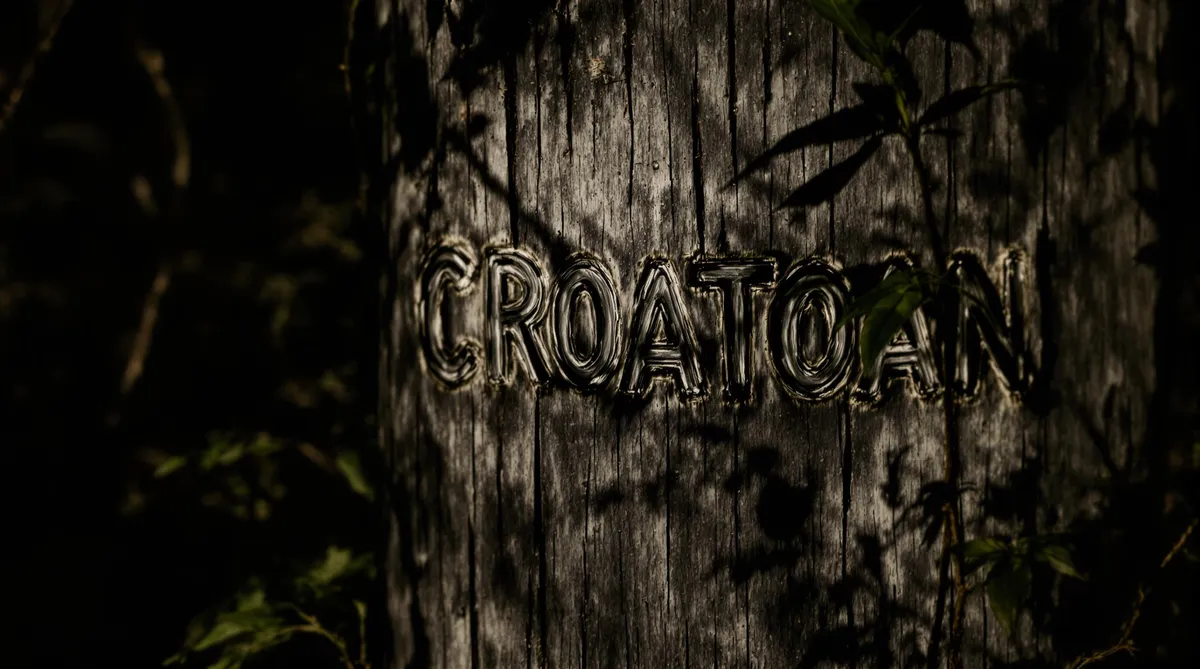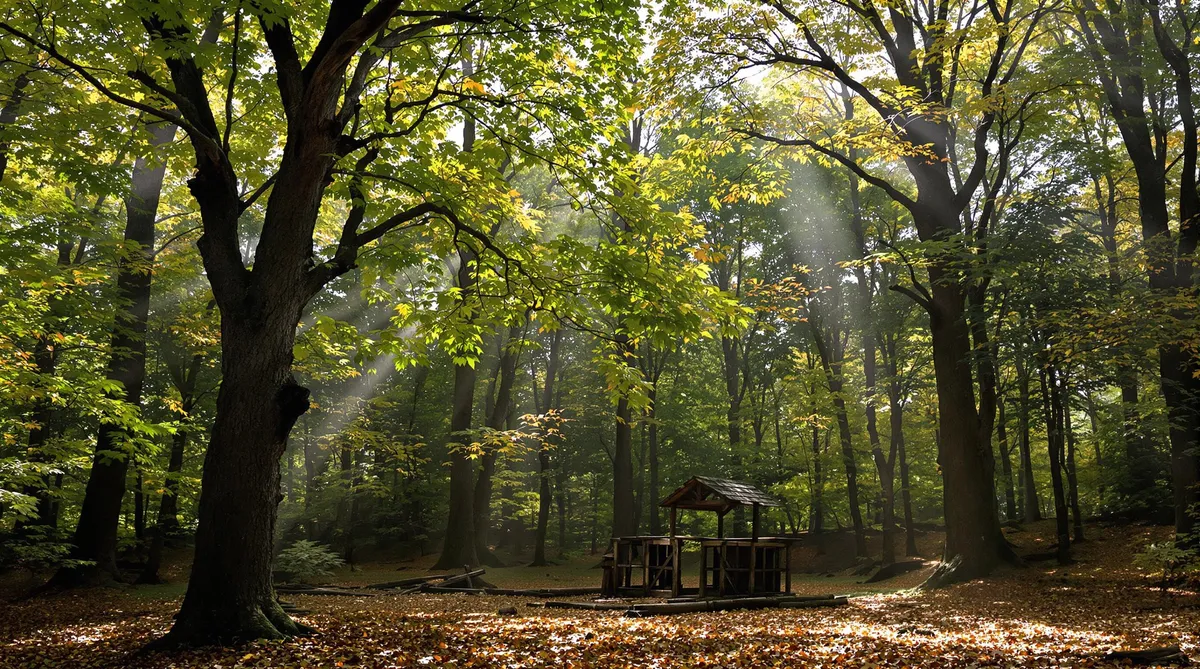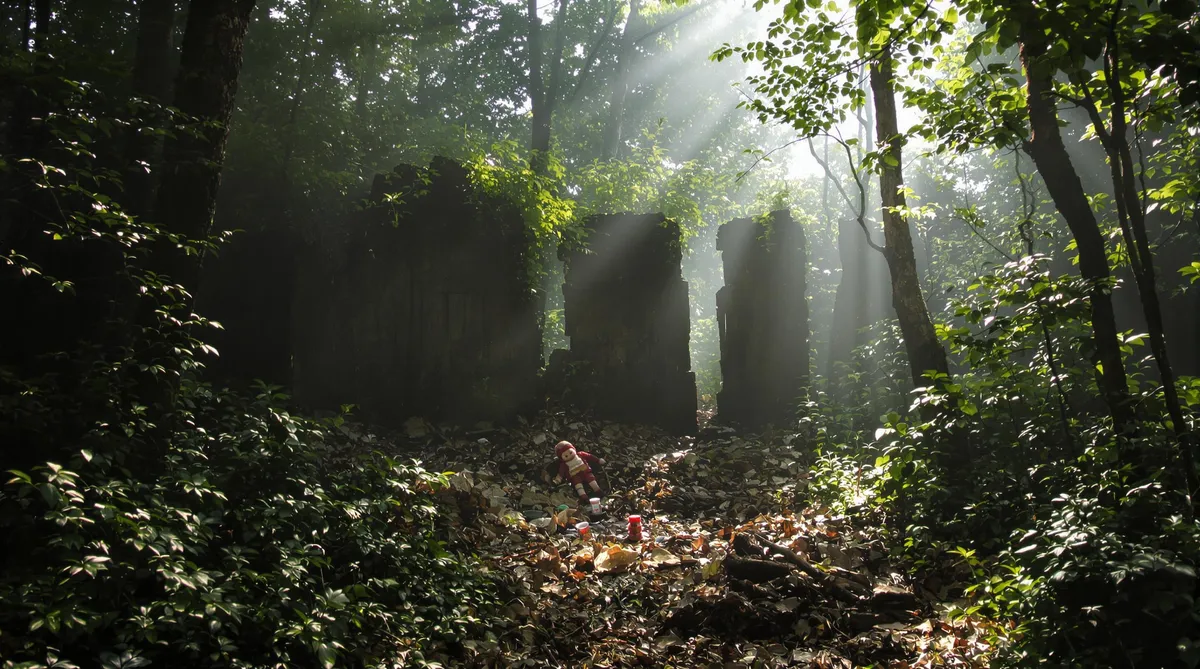The Lost Colony of Roanoke

The Lost Colony of Roanoke, established in 1585 under Sir Walter Raleigh’s charter, presents a historical enigma that has baffled scholars for centuries.
With the word “CROATOAN” as the only clue left behind, the fate of the colonists remains shrouded in mystery. Strained relations with indigenous tribes and inhospitable conditions only deepen the intrigue.
Modern archaeology and technology continue to probe the unanswered questions, leaving one to ponder what truly became of Roanoke’s settlers.
TL;DR
Hide- The Lost Colony of Roanoke was established in 1585 but mysteriously disappeared by 1590.
- The word "CROATOAN" was the only clue left behind, carved into a post.
- Theories suggest colonists integrated with local tribes or faced a tragic fate.
- Modern archaeological tools reveal European artifacts, hinting at relocation or assimilation.
- Roanoke's mystery endures in popular culture, inspiring books, films, and TV shows.
The Mystery Begins: Roanoke’s Founding and Early Days
In 1585, Sir Walter Raleigh’s vision of establishing the first English settlement in the New World materialized with the foundation of Roanoke Island.
However, it was not until John White‘s second wave of colonists in 1587 that the settlement gained new momentum and hope for permanence.
This fresh start was marked by enthusiastic preparations and a strategic partnership with the local Algonquian tribes, yet it also faced significant challenges that would soon spiral into one of history’s most perplexing enigmas.
Establishing the First English Settlement in America

Sir Walter Raleigh’s ambitious vision for establishing the first English settlement in America was rooted in the promise of new opportunities and strategic advantage over rival European powers.
However, the settlers at Roanoke faced formidable challenges, including harsh environmental conditions, limited resources, and strained relations with local Indigenous populations.
These early trials set the stage for a mystery that would confound historians for centuries, as the colony’s initial struggles foreshadowed the enigmatic disappearance that would follow.
Sir Walter Raleigh’s Ambitious Vision
The grand vision of establishing a lasting English presence in the New World was spearheaded by the ambitious explorer Sir Walter Raleigh.
Driven by dreams of glory and wealth, Raleigh envisioned Roanoke as a foothold for expanding English influence. His strategy paired exploration with colonization, promising opportunities for both settlers and the crown.
This visionary expedition, however, faced the unpredictable challenges of an untamed land and distant governance.
Challenges Faced by the First Settlers
Despite the promise of new beginnings, Roanoke’s settlers faced formidable challenges from the moment they set foot on the unfamiliar shores of what is now North Carolina.
The wilderness was both a mystery and a threat, with its dense forests and unpredictable weather. Supplies dwindled rapidly, while tensions with native tribes added a layer of peril.
Isolation compounded their plight, fostering uncertainty and fear of the unknown.
The Second Wave: John White and a Fresh Start
In 1587, John White led a group of 115 English colonists, including families with women and children, to establish a permanent settlement at Roanoke Island, marking a renewed attempt to colonize the New World.
Despite initial aspirations of prosperity and cooperation with local tribes, the settlers soon faced harsh realities, including dwindling supplies and strained relations with Native Americans.
This fresh start, burdened by logistical challenges and isolation, set the stage for a mystery that endures to this day.
Who Were the New Colonists?
A wave of optimism and ambition accompanied the new colonists as they commenced their journey to Roanoke under the leadership of John White in 1587.
The settlers were a diverse group, including:
- Craftsmen – essential for building and maintenance tasks.
- Farmers – to cultivate the land and guarantee sustenance.
- Women and children – integral for establishing a community.
- Merchants – to facilitate trade and economic growth.
Initial Hopes and Early Struggles
Amid the dense forests and untamed wilderness of Roanoke, the initial hopes of the newly arrived colonists were as boundless as the Atlantic they’d crossed.
Yet, these dreams soon collided with harsh realities. Scarcity of food, unyielding weather, and strained relations with indigenous tribes tested their resolve.
The promise of a thriving settlement waned as survival became an arduous, daily challenge, shadowing their quest for new beginnings.
The Colony’s Sudden Disappearance

Governor John White’s departure from Roanoke left the fledgling colony vulnerable, as his absence extended far longer than anticipated due to the Anglo-Spanish War.
Upon his delayed return, White was confronted with the chilling enigma of the word “CROATOAN” etched into a wooden post, a sole clue that tantalized more than it revealed.
This cryptic message, lacking any signs of distress, has since fueled speculation about the settlers’ fate, ranging from voluntary integration with local tribes to more ominous scenarios.
The Departure of Governor John White
Governor John White departed from the Roanoke Colony in 1587 with the intent to swiftly return with provisions and reinforcements, leaving behind a settlement on the brink of potential prosperity but also vulnerability.
Anticipating a brief absence, he expected to find a thriving community upon his return, fortified and resilient against the challenges of the New World.
However, the unforeseen delay of three years due to the Anglo-Spanish War shattered these expectations, leaving him to confront an inexplicably empty settlement marked only by the enigmatic inscription “CROATOAN.”
Why White Left and What He Expected Upon Return
As the year 1587 drew to a close, John White faced a difficult decision that would ultimately shape the enigmatic fate of the Roanoke Colony.
He departed for England seeking:
- Supplies: Critical provisions to sustain the settlers.
- Reinforcements: Additional manpower for security.
- Assurances: Confirmation of continued support from the Crown.
- Swift Return: A quick voyage back with hope of finding the colony thriving.
The Mysterious Word: CROATOAN
The inscription “CROATOAN” remains the most tantalizing clue to the fate of Roanoke’s vanished colonists, its meaning shrouded in ambiguity and speculation.
This single word, carved into a fort post, has sparked theories ranging from a deliberate relocation to Hatteras Island, where the friendly Croatoan tribe resided, to a potential distress signal or even a coded message.
Alongside this enigmatic word, the absence of traditional distress markers and any sign of struggle invites questions about the colonists’ intentions and the circumstances surrounding their disappearance.
What Did “Croatoan” Really Mean?
Intrigue surrounds the enigmatic word “CROATOAN,” found carved into a post upon the deserted site of Roanoke Colony.
This singular clue ignites speculation across time, inviting exploration of its meaning:
- Signal of Relocation: Did colonists plan to join the Croatoan tribe?
- Desperate Message: A plea for rescue or direction?
- Cultural Integration: Suggesting peaceful assimilation?
- Symbol of Hope: A beacon for possible survival?
Clues Left Behind at Roanoke
Upon Governor John White’s return to Roanoke in 1590, the deserted settlement presented an unsettling tableau, with the word “CROATOAN” etched into a wooden post as its sole indication of the colonists’ fate.
This enigmatic clue, carved with deliberate intention, hinted at either a voluntary migration or a dire necessity. Its stark simplicity invited speculation, encouraging minds to seek freedom beyond conventional explanations and explore the boundless possibilities of human resilience.
Exploring the Leading Theories
The enigmatic disappearance of the Roanoke colonists has spurred a triad of compelling theories, each offering a distinct path through the mists of history.
Some suggest a peaceful integration with local tribes, where the settlers may have found sanctuary in assimilation, adapting to indigenous customs and lifestyles.
Others hypothesize that the colonists, driven by desperation, attempted a perilous sea voyage that ended in tragedy, while a more sinister theory posits that violence and conflict led to their untimely demise at the hands of hostile forces.
Integration with Local Tribes: Survival Through Assimilation?
The theory of assimilation with local tribes rests on a foundation of archaeological findings and compelling oral histories passed down through generations.
Artifacts such as European-style ceramics and tools discovered near Native American settlements suggest a blending of cultures, while legends among the Croatoan and other tribes hint at the presence of European settlers integrating into their communities.
These narratives, combined with ongoing DNA research, paint a picture of possible survival through adaptation and highlight the resilience of the Roanoke settlers in the face of adversity.
Evidence Supporting Native American Integration
Although the fate of the Roanoke colonists remains shrouded in mystery, evidence supporting their integration with local Native American tribes offers a compelling narrative.
Consider the following:
- Artifacts: European items found within Native settlements.
- Linguistic traces: English words in tribal dialects.
- Genetic markers: Traces of European ancestry in local descendants.
- Cultural exchanges: Blended traditions and practices observed historically.
These elements suggest a harmonious assimilation, expanding the sphere of possibility.
Local Legends and Oral Histories
Evidence of integration, compelling as it may be, gains further depth when considered alongside local legends and oral histories.
Tales passed down through generations suggest the colonists merged with indigenous tribes, adopting customs and languages. These stories, rich in cultural nuance, paint a picture of survival through adaptation.
They imply a blending of identities, where freedom was found in unity, transcending the boundaries of their origins.
Lost at Sea: Did the Colonists Attempt to Sail Away?
In the shadow of the turbulent 16th-century seas, the possibility that Roanoke’s colonists attempted a desperate maritime escape presents a haunting question.
Despite the known maritime risks of the era, including unpredictable currents and inadequate navigation tools, the absence of any shipwreck or related artifacts leaves the notion speculative at best.
This lack of physical evidence challenges researchers to imagine a scenario where settlers, driven by urgency and isolation, might have commenced on a perilous voyage into oblivion.
Maritime Risks and Historical Context
The turbulent waters of the Atlantic Ocean and the treacherous conditions of the Elizabethan era posed significant maritime risks for the Roanoke colonists.
Steering through these dangers required:
- Robust vessels to withstand unpredictable storms.
- Astute seamanship to manage the coastal currents.
- Accurate navigation to avoid becoming lost at sea.
- Adequate provisions to sustain life during extended voyages.
These factors shaped their perilous maritime journey.
Lack of Physical Evidence
Steering through the perilous waters of the Atlantic was just one of many challenges facing the Roanoke colonists, yet the absence of physical evidence at their deserted settlement remains a confounding aspect of their mysterious disappearance.
No wreckage, personal belongings, or signs of a hasty departure have surfaced. Did they craft a makeshift vessel, succumbing to the merciless ocean, leaving no trace behind?
Violence and Conflict: Were the Colonists Attacked?
The mysterious disappearance of the Roanoke colonists has led some historians to hypothesize that escalating tensions with local Indigenous groups may have culminated in violence.
While no explicit evidence of a violent struggle was found at the site, the colonists’ precarious relationship with neighboring tribes and the English crown’s own records of prior hostilities suggest potential conflict.
The enigmatic “CROATOAN” carving further complicates the narrative, hinting at either a forced evacuation or a more benign integration that remains shrouded in ambiguity.
Potential Conflicts with Indigenous Groups
Amidst the numerous theories surrounding the fate of Roanoke’s lost colonists, the potential for conflict with Indigenous groups presents a compelling yet contentious possibility.
Various factors could have led to tensions:
- Resource Competition: Struggles over food and land.
- Cultural Misunderstandings: Misinterpreted intentions leading to hostilities.
- Alliances and Rivalries: Existing tribal dynamics.
- European Aggression: Prior encounters sparking retaliatory actions.
Historical Tensions and Possible Outcomes
While the disappearance of Roanoke’s colonists remains shrouded in mystery, the theory of violent conflict offers a stark lens through which to examine their fate.
Intrigued by the absence of bodies or struggle indicators, historians ponder whether tensions with local tribes escalated into violence.
Yet, without physical evidence or survivor accounts, the theory remains speculative, leaving room for other interpretations amidst the shadows of history.
Archaeological Searches and Recent Discoveries
Archaeological efforts aimed at solving the mystery of the Lost Colony have intensified, with significant investigations uncovering European artifacts far from the original settlement site.
Utilizing cutting-edge technology such as ground-penetrating radar and DNA analysis, researchers are piecing together clues that suggest possible relocation or integration scenarios.
These discoveries, including a concealed fort on the “Map with Patch,” offer tantalizing insights into the colonists’ fate, hinting at a complex narrative beyond the initial disappearance.
Digging into the Past: Key Archaeological Investigations
Recent archaeological endeavors have unearthed a trove of European artifacts on the mainland, some 50 miles from the original Roanoke settlement, suggesting the possibility of relocation or interaction with indigenous groups.
These discoveries, coupled with the enigmatic “Map with Patch” indicating a concealed fort, have reignited scholarly debate and prompted a reevaluation of the colonists’ fate.
As researchers meticulously analyze these findings, the implications extend beyond mere historical curiosity, challenging long-held assumptions about early colonial interactions and migration patterns.
Notable Excavations and Findings
Revealing the enigmas of history, archaeologists have initiated numerous excavations to uncover the truth behind the Lost Colony of Roanoke.
Their findings have intrigued and perplexed many:
- European Artifacts: Unearthed 50 miles from Roanoke, suggesting possible migration routes.
- “Map with Patch”: A hidden fort marking hinting at undisclosed plans.
- Ceramic Fragments: Indicating trade or assimilation.
- DNA Evidence: Tracing European lineage among Native tribes.
Latest Developments and Their Implications
As researchers continue to sift through the layers of history, the quest to unearth the fate of the Lost Colony of Roanoke has taken on renewed vigor.
Recent archaeological searches have uncovered tantalizing artifacts, hinting at possible integration with Native tribes.
The discovery of European goods amidst indigenous sites challenges established narratives, inviting a reimagining of cultural interactions and urging exploration beyond conventional boundaries.
Technology’s Role in Uncovering New Evidence
Recent technological advancements are revolutionizing the search for answers to the Roanoke enigma.
Ground-penetrating radar and advanced satellite imagery have revealed previously hidden structures and pathways, allowing archaeologists to reimagine the landscape as it once was.
These tools, coupled with cutting-edge DNA analysis, are piecing together a narrative that transcends historical records, offering fresh insights into the fate of the vanished settlers.
Modern Tools Helping Solve Historical Mysteries
How can modern technology unravel the enigmas of the past? By employing advanced methods, researchers are piecing together forgotten narratives.
- LIDAR Imaging: Penetrates dense foliage, revealing hidden structures.
- Ground-Penetrating Radar: Detects subterranean anomalies without excavation.
- DNA Analysis: Traces lineage, linking settlers to Native populations.
- 3D Mapping: Reconstructs ancient landscapes, offering new perspectives.
These tools empower historians to explore beyond traditional boundaries.
The Roanoke Mystery in Popular Culture
The enigma of the Lost Colony of Roanoke has permeated popular culture, inspiring a multitude of books, movies, and television shows that explore its haunting narrative.
This enduring mystery has captured the collective imagination, offering fertile ground for creative interpretations and speculative storytelling.
Its legacy persists, as audiences remain intrigued by the unanswered questions and the eerie simplicity of the word “CROATOAN” that continues to echo through time.
Books, Movies, and TV Shows Inspired by Roanoke
The enigmatic disappearance of the Roanoke Colony has fueled a myriad of creative interpretations across books, movies, and television, each contributing to the public’s perception of this historical puzzle.
These fictional portrayals often blend fact with imagination, crafting narratives that range from supernatural explanations to speculative historical dramas.
How Fiction Shapes Public Understanding
Why does the mystery of Roanoke persist so vividly in the popular imagination?
Fictional portrayals captivate with their blend of history and speculation, shaping public perception. This intersection allows creative freedom and exploration of untold narratives.
Consider these influences:
- Novels: Intrigue-filled plots weave historical context.
- Films: Visual storytelling enhances suspense.
- TV series: Episodic formats develop complex theories.
- Documentaries: Combine facts with imaginative hypotheses.
Roanoke’s Enduring Legacy and Appeal
The Lost Colony of Roanoke continues to captivate the public imagination due to its enigmatic disappearance and the tantalizing possibilities it presents.
This mystery invites endless speculation rooted in its sparse historical evidence, such as the lone “CROATOAN” carving and obscure maps, which challenge both amateur sleuths and seasoned historians.
Its appeal lies not only in the quest for answers but also in the broader narrative of human resilience, cultural interaction, and the haunting possibility of vanishing without a trace.
Why the Lost Colony Continues to Fascinate Us
How does a centuries-old mystery continue to capture the imagination of countless generations? The enigma of the Lost Colony of Roanoke endures due to its blend of history and intrigue, appealing to the human spirit of exploration and discovery.
Consider these factors:
- Unanswered Questions: The absence of conclusive evidence.
- Cultural Impact: Influence on literature and art.
- Speculation: Stimulating imaginative theories.
- Archaeological Pursuits: Ongoing searches for clues.
Wrapping Up
The enigma of Roanoke endures, a tapestry woven with strands of history and speculation, inviting endless curiosity.
As investigators peel back layers of time, the colony’s fate remains elusive, much like a shadow that shifts with the light, defying capture.
This mystery, nestled at the intersection of myth and reality, continues to captivate, reminding us that some stories resist closure, instead serving as perpetual invitations to explore the depths of human history and imagination.





